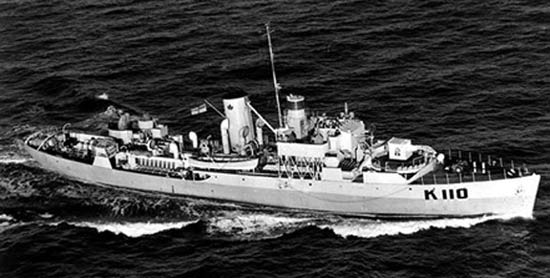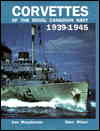Allied Warships
HMCS Shediac (K 110)
Corvette of the Flower class

HMCS Shediac in late 1944 or 1945.
| Navy | The Royal Canadian Navy |
| Type | Corvette |
| Class | Flower |
| Pennant | K 110 |
| Built by | Davie Shipbuilding and Repairing Co. Ltd. (Lauzon, Quebec, Canada) |
| Ordered | 22 Jan 1940 |
| Laid down | 5 Oct 1940 |
| Launched | 29 Apr 1941 |
| Commissioned | 8 Jul 1941 |
| End service | 28 Aug 1945 |
| History | Fo'c's'le extention at Vancouver (British Columbia, Canada) completed on 18 August 1944. Decommissioned 28 August 1945. |
Commands listed for HMCS Shediac (K 110)
Please note that we're still working on this section
and that we only list Commanding Officers for the duration of the Second World War.
| Commander | From | To | |
| 1 | T/Lt. John Oswald Every-Clayton, RCNR | 3 Jun 1941 | 22 Mar 1943 |
| 2 | T/Lt. Arthur Moorhouse, RCNR | 23 Mar 1943 | 9 Feb 1944 |
| 3 | T/Skr.Lt. Joseph Bernard Cooper, RCNR | 10 Feb 1944 | 30 Mar 1944 |
| 4 | T/A/Lt.Cdr. Thomas Philip Ryan, RCNR | 31 Mar 1944 | 31 Jul 1944 |
| 5 | T/A/Lt.Cdr. Paul Dalrymple Taylor, RCNVR | 1 Aug 1944 | 25 Jun 1945 |
| 6 | T/Lt. William McCombe, RCNR | 26 Jun 1945 | 28 Aug 1945 |
You can help improve our commands section
Click here to Submit events/comments/updates for this vessel.
Please use this if you spot mistakes or want to improve this ships page.
Notable events involving Shediac include:
12 May 1942
HMCS Shediac (T/Lt. J.E. Clayton, RCNR) picks up 25 survivors from the British merchant Empire Dell that was torpedoed and sunk by German U-boat U-124 in the North Atlantic in position 53°00'N, 29°57'W.
HMCS Shediac also picks up 37 survivors from the British merchant Cristales that was torpedoed and sunk by German U-boat U-124 in the North Atlantic in position 52°55'N, 29°50'W.
27 Dec 1942
HMCS Shediac (T/Lt. J.E. Clayton, RCNR) picks up 27 survivors from the British merchant Melrose Abbey that was torpedoed and sunk by German U-boat U-356 north-north-east of the Azores in position 47°30'N, 24°30'W.
28 Dec 1942
HMCS Shediac (T/Lt. J.E. Clayton, RCNR) picks up 35 survivors from the British merchant Melmore Head that was torpedoed and sunk by German U-boat U-225 north of the Azores in position 43°27'N, 27°15'W.
4 Mar 1943
German U-boat U-87 was sunk west of Leixoes, in position 41°36'N, 13°31'W, by depth charges from the Canadian corvette HMCS Shediac (Lt. J.E. Clayton, RCNR) and the Canadian destroyer HMCS St. Croix (A/Lt.Cdr. A.H. Dobson, DSC, RCNR).
6 Mar 1943
HMCS Shediac (T/Lt. J.E. Clayton, RCNR) picks up survivors from the British merchant Fort Battle River that was torpedoed and sunk by German U-boat U-410 west of Gibraltar in position 36°33'N, 10°22'W.
28 Mar 1943
HMS H 44 (Lt. P.S. Beale, RN) conducted A/S exercises off Lough Foyle with HMS Erne (Lt.Cdr. E.D.J. Abbot, DSC, RN), HMS Clare (Lt.Cdr. J.P. Stewart, DSC, RD, RNR), HMCS Shediac (Lt. J.O. Every-Clayton, RCNR), HMCS St. Laurent (Lt.Cdr. G.H. Stephen, OBE, DSC, RCNR), HMCS Kenogami (T/Lt. J.L. Percy, RCNVR) and HMCS Battleford (T/Lt. F.A. Beck, RCNVR). (1)
24 Oct 1943
Convoy SC 145.
This convoy departed Halifax on 24 October 1943.
On departure from Halifax the convoy was made up of the following merchant vessels; Agwistar (American, 4661 GRT, built 1919), Athelprince (British (tanker), 8782 GRT, built 1926), Atlantic (Panamanian, 6132 GRT, built 1919), Baltrover (British, 4916 GRT, built 1913), Baron Dunmore (British, 3938 GRT, built 1933), Bayou Chico (American, 5401 GRT, built 1920), Benedick (British (tanker), 6978 GRT, built 1928), Bonaire (Dutch, 3164 GRT, built 1926), Boston City (British, 2870 GRT, built 1920), Chr. Th. Boe (Norwegian (tanker), 6192 GRT, built 1930), Clam (British, 7404 GRT, built 1927), Delmar (American, 5107 GRT, built 1920), Dundee (British, 1541 GRT, built 1934), El Ciervo (British (tanker), 5841 GRT, built 1923), El Grillo (British (tanker), 7264 GRT, built 1922), Fort Slave (British, 7134 GRT, built 1942), Gudfor (Norwegian, 2280 GRT, built 1928), Gyda (British, 1695 GRT, built 1934), H.M. Flagler (Panamanian (tanker), 8208 GRT, built 1918), Kingman (Panamanian, 1513 GRT, built 1934), Leerdam (Dutch, 8815 GRT, built 1921), Maycrest (British, 5923 GRT, built 1913), Michigan (Panamanian (former French), 6419 GRT, built 1920), Orwell (Norwegian (tanker), 7920 GRT, built 1905), Pacific Shipper (British, 6290 GRT, built 1924), San Felix (British (tanker), 13037 GRT, built 1921), San Valerio (British (tanker), 6493 GRT, built 1913), Sarazen (British, 5401 GRT, built 1920), Sulev (British (former Estonian), 2233 GRT, built 1908), Van de Velde (Dutch, 6389 GRT, built 1919), Vav (Norwegian (tanker), 6415 GRT, built 1931) and Wisla (Polish, 3108 GRT, built 1928).
On departure from Halifax the convoy was escorted by the destroyer HMCS Annapolis (Lt.Cdr. A.G. Boulton, RCNVR) and the corvettes HMCS Kenogami (T/Lt. J.L. Percy, RCNVR), HMCS Saskatoon (Lt.Cdr. T. MacDuff, RCNR) and HMCS Shediac (T/A/Lt.Cdr. A. Moorhouse, RCNR).
The minesweeper HMCS Clayoquot (T/Lt. C.L. Campbell, RCNVR) was with the convoy during 25/26 October 1943.
On 28 October 1943, the original escort from Halifax parted company to proceed to St. Johns, Newfoundland after the relief escort had joined coming from St. Johns. This relief escort was made up of the destroyers HMS Fame (Cdr. R.A. Currie, RN), HMS Vanquisher (Lt.Cdr. G.A.G. Ormsby, RN), frigates HMS Deveron (Lt.Cdr. R.E.H. Partington, RD, RNR), HMS Domett (T/A/Lt.Cdr. S. Gordon, RNVR) and the corvettes HNoMS Potentilla, HNoMS Rose and HMS Linaria (T/A/Lt.Cdr. R.H. Jameson, RNR).
Around 1105P/29 the escort carrier HMS Fencer (Capt. E.W. Anstice, RN) and the destroyers HMS Inconstant (Cdr. R.H. Mills, RN), ORP Garland (Kmdr.ppor. (Cdr.) S. Biskupski) and ORP Burza (Kmdr.ppor. (Cdr.) F. Pitulko) joined the convoy. They parted comanay with the convoy to proceed to the Clyde around 1320N/2.
The convoy arrived in U.K. waters on 6 November 1943.
8 Feb 1944
Convoy ON 223.
This convoy was assembled in the North Channel on 8 February 1944.
It was made up of the following merchant vessels; A.J. Cermak (American, 7176 GRT, built 1943), Alabaman (American, 7033 GRT, built 1921), Alcoa Cutter (American, 5057 GRT, built 1918), Alcoa Trader (American, 5590 GRT, built 1920), Ameriki (Greek, 7176 GRT, built 1943), Atlanta City (American, 5686 GRT, built 1921), British Promise (British (tanker), 8443 GRT, built 1942), Caxton (British, 7271 GRT, built 1943), Ceronia (Dutch (tanker), 8096 GRT, built 1939), Champ Clark (American, 7196 GRT, built 1942), Charles C. Jones (American, 7198 GRT, built 1943), Columbian (American, 6310 GRT, built 1913), Daghestan (British, 7248 GRT, built 1941), Duala (Norwegian, 1800 GRT, built 1938), Duke of Athens (British, 5217 GRT, built 1940), Edwin L. Godkin (American, 7198 GRT, built 1943), Empire MacAlpine (British (MAC ship), 7954 GRT, built 1943), Empire Sceptre (British, 7359 GRT, built 1944), Fagerfjell (Norwegian (tanker), 8072 GRT, built 1935), Fort Moose (British, 7130 GRT, built 1943), Frithjof Nansen (Norwegian, 7177 GRT, built 1943), George Berkeley (American, 7176 GRT, built 1943), Hawaiian (American, 6270 GRT, built 1919), Hindustan (British, 5245 GRT, built 1940), Hoke Smith (American, 7199 GRT, built 1943), Howell E. Jackson (American, 7176 GRT, built 1943), Idefjord (Norwegian, 4287 GRT, built 1921), J.L. Luckenbach (American, 6369 GRT, built 1919), James McHenry (American, 7191 GRT, built 1943), James Rumsey (American, 7181 GRT, built 1942), Joel R. Poinsett (American, 7176 GRT, built 1943), John A. Brown (British (tanker), 10455 GRT, built 1938), John Catron (American, 7176 GRT, built 1943), John Sedgwick (American, 7176 GRT, built 1942), Joshua B. Lippencott (American, 7176 GRT, built 1943), Katrina Luckenbach (American, 5854 GRT, built 1918), Lombardy (British, 3379 GRT, built 1921), Mexican (American, 8030 GRT, built 1907), Naranio (British (tanker), 8134 GRT, built 1943), Norheim (Norwegian (tanker), 9816 GRT, built 1941), Oliver Hazard Perry (American, 7176 GRT, built 1942), Palembang (Dutch, 7070 GRT, built 1921), Peter Cartwright (American, 7176 GRT, built 1942), Raranga (British, 10043 GRT, built 1916), Riverview Park (Canadian, 7130 GRT, built 1943), Roger Griswold (American, 7191 GRT, built 1943), Samuel Moody (American, 7176 GRT, built 1942), Stephen C. Foster (American, 7196 GRT, built 1943), Sun Yat-Sen (American, 7176 GRT, built 1943), Tetela (British, 5389 GRT, built 1926), Thomas F. Cunningham (American, 7218 GRT, built 1943), Tigre (Norwegian, 5498 GRT, built 1926), Walter Raleigh (American, 7177 GRT, built 1943), Webb Miller (American, 7176 GRT, built 1943), William Grayson (American, 7191 GRT, built 1942), William Paca (American, 7191 GRT, built 1942), William Tilghman (American, 7191 GRT, built 1942) and Woodrow Wilson (American, 7177 GRT, built 1943).
The rescue ship Zamalek (British, 1567 GRT, built 1921) was also part of the convoy.
On assembly the convoy was escorted by the frigates HMS Conn ( Lt. C.D.T. Williams, RN), HMS Chelmer (T/A/Lt.Cdr. R.A. Cherry, RNR) and the corvettes HMS Kenilworth Castle (Lt. J.J.Allon, RNR), HMS Portchester Castle (Lt. A.G. Scott, RNR), HMS Pink (Lt. W.K. Tadman, RNR) and HMS Sunflower (A/Lt.Cdr. J. Plomer, DSC, RCNVR).
A support group made up of the escort carriers HMS Striker (Capt. F.M. Walton, RN), HMS Fencer (A/Capt. W.W.R. Bentinck, OBE, RN) and the sloops HMS Woodcock (Cdr.(Retd.) J.F. Blackburn, DSO, RN), HMS Whimbrel (Lt.Cdr. W.J. Moore, DSC, RNR), HMS Hart (Cdr.(Retd.) M.B. Sherwood, DSO and Bar, RN), HMS Crane (Lt.Cdr. R.G. Jenkins, RN) and the frigates HMS Spey (Cdr. G.A.G. Ormsby, RN, Senior Officer of the A/S vessels of the group), HMS Findhorn (Lt.Cdr. J.C. Dawson, RD, RNR), HMS Lossie (Lt.Cdr. A.F. MacFie, OBE, RNR), HMS Rother (Cdr. Y.M. Cleeves, DSO, DSC, RD, RNR) and HMS Wear (Lt.Cdr. Gerald MacClelland, DSC, RN) was also with the convoy until 11 February 1944 when left to conduct A/S operations in the central North Atlantic.
Several of the merchant vessels were forced to return to the U.K., these were the Alabaman, Joel R. Poinsett, Katrina Luckenbach and Lombardy. Of these the Alabaman had lost her rudder on the 11th and she then fell out of the convoy and had to be towed back. HMS Pink remained with her for A/S protection.
On 18 February 1944, the merchant vessel J.L. Luckenbach and the current escort parted company with the convoy to proceed to Newfoundland. The transport and HMS Sunflower proceeded to St. Johns while the two frigates and the two Castle-class corvettes proceeded to Argentia. On these ships parted company a new escort took over. This was made up of the corvettes HMCS Cobalt (T/A/Lt.Cdr. R.A. Judges, RCNVR), HMCS Timmins (T/A/Lt.Cdr. H.S. Maxwell, RCNVR), HMCS Trail (T/Lt. G.M. Hope, RCNVR) and the minesweeper HMCS Winnipeg (T/A/Lt.Cdr. W.D.F. Johnston, RCNR). They had departed St. Johns on 17 February 1944.
On 21 February 1944, the merchant vessels Champ Clark, Duala, rescue ship Zamalek, Mac Ship Empire MacAlpine and the current escort parted company with the convoy to proceed to Halifax where they arrived on 22 February 1944. On these ships parted company a new escort took over. This was made up of the corvettes HMCS Kenogami (T/Lt. J.L. Percy, RCNVR), HMCS Shediac (T/Skr.Lt. J.B. Cooper, RCNR) and the minesweeper HMCS Wallaceburg (T/A/Lt.Cdr. F.R. Naftel, RCNVR).
The convoy arrived at New York on 24 February 1944.
Media links
|
Sources
- ADM 173/17814
ADM numbers indicate documents at the British National Archives at Kew, London.
As an Amazon Associate uboat.net earns a commission from qualifying purchases.

